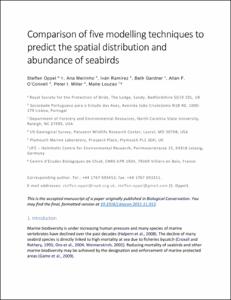Comparison of five modelling techniques to predict the spatial distribution and abundance of seabirds.

Average rating
votes
Date
2012Author
Oppel, Steffen
Meirinho, Ana
Ramírez, Iván
Gardner, Beth
O’Connell, Allan F.
Miller, Peter I.
Louzao, Maite
Metadata
Show full item recordAbstract
The number and complexity of modelling techniques used to predict species distributions has
increased substantially over the past decades (Hegel et al., 2010), and several comparisons of
model performance have been carried out for terrestrial species (e.g., Elith and Graham, 2009;
Elith et al., 2006; Segurado and Araújo, 2004). In contrast, the marine environment is less
studied and more challenging given its dynamic nature (Ready et al., 2010; Robinson et al.,
2011; Wakefield et al., 2009). Furthermore, seabirds are highly mobile species, and their
presence at certain locations varies temporally depending on whether an area is used during
the breeding season, as a migration stopover, or as moult refuge (Tremblay et al., 2009). A
comparison of the performance of different models that predict distributions and abundances
of seabirds based on shipboard survey data has to our knowledge only been explored for one
coastal species (Yen et al., 2004), yet the bourgeoning interest in.....
Journal
Biological ConservationVolume
156Page Range
pp.94-104Document Language
enSustainable Development Goals (SDG)
14.aEssential Ocean Variables (EOV)
Marine turtles, birds, mammals abundance and distributionDOI Original
https://doi.org/10.1016/j.biocon.2011.11.013Citation
Oppel S., Meirinho A., Ramirez I., Gardner B., O'Connell A.F., Miller P.I. and Louzao M. (2012) Comparison of five modelling techniques to predict the spatial distribution and abundance of seabirds. Biological Conservation, 156, pp.94-104. DOI: https://doi.org/10.1016/j.biocon.2011.11.013Collections
 Repository of community practices in Ocean Research, Applications and Data/Information Management
Repository of community practices in Ocean Research, Applications and Data/Information Management